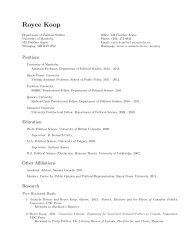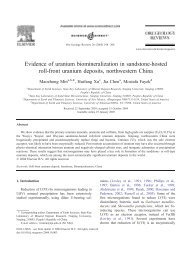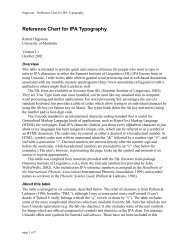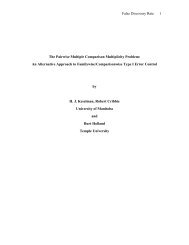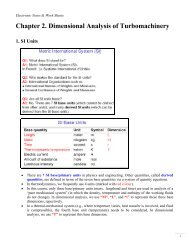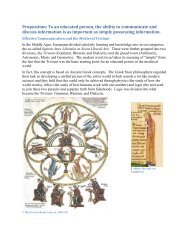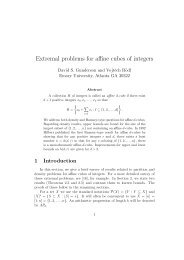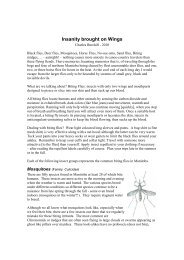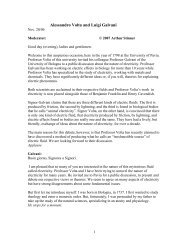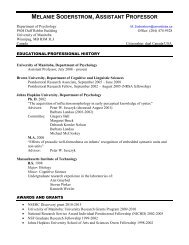Newsletter - University of Manitoba
Newsletter - University of Manitoba
Newsletter - University of Manitoba
Create successful ePaper yourself
Turn your PDF publications into a flip-book with our unique Google optimized e-Paper software.
The Entomological Society <strong>of</strong> <strong>Manitoba</strong><br />
<strong>Newsletter</strong><br />
Volume 37 Number 3 ISSN 0836-5830 Winter 2010<br />
About the ESM<br />
<strong>Newsletter</strong><br />
The Entomological Society <strong>of</strong><br />
<strong>Manitoba</strong> <strong>Newsletter</strong> is<br />
published three times per year.<br />
It is a forum whereby<br />
information can be<br />
disseminated to Society<br />
members. As such, all<br />
members are encouraged to<br />
contribute <strong>of</strong>ten. The<br />
<strong>Newsletter</strong> is interested in<br />
opinions, short articles, news<br />
<strong>of</strong> research projects, meeting<br />
announcements, workshops,<br />
courses and other events,<br />
requests for materials or<br />
information, news <strong>of</strong><br />
personnel or visiting scientists,<br />
literature reviews or<br />
announcements and anything<br />
that may be <strong>of</strong> interest to ESM<br />
members.<br />
Pat MacKay, Editor 1<br />
Mahmood Iranpour, Editor 2<br />
Dept. <strong>of</strong> Entomology,<br />
<strong>University</strong> <strong>of</strong> <strong>Manitoba</strong><br />
Winnipeg, <strong>Manitoba</strong><br />
R3T 2N2<br />
1 Ph. (204) 452-4025<br />
pa_mackay@umanitoba.ca<br />
2 Ph. (204) 474-6994<br />
iranpour@cc.umanitoba.ca<br />
Editors’ Comments<br />
A belated Happy New<br />
Year! This issue <strong>of</strong> the<br />
<strong>Newsletter</strong> is being<br />
produced at the same<br />
time as one <strong>of</strong> your<br />
editors (PM) prepares<br />
to head to the southern<br />
hemisphere, where it<br />
is warmer than<br />
<strong>Manitoba</strong>. In this issue<br />
we bring you greetings from your new President, Taz<br />
Stuart. There’s a report on the details <strong>of</strong> the October 2010<br />
ESM Annual Meeting, with photos <strong>of</strong> our award winners.<br />
Terry Galloway, your Regional Director, reports on the<br />
responsibilities and activities <strong>of</strong> a Regional Director.<br />
Alicia Leroux, your Member-at-Large, reports on the ESC<br />
Meeting in Vancouver. On the topic <strong>of</strong> Member News,<br />
there are some photos <strong>of</strong> Reiny Brust at the ESC Meeting,<br />
there’s a note on taxonomic recognition <strong>of</strong> Rob Roughley,<br />
and a note on Sunday Oghiakhe, and his recent illness. The<br />
second half <strong>of</strong> Bob Wrigley’s 2008 collecting trip is also in<br />
this issue. Then there are the usual items: meeting<br />
announcements and the list <strong>of</strong> Society Officers and<br />
Committee Chairs. Finally, mailed with this issue is the<br />
most recent membership list. We both hope that the rest <strong>of</strong><br />
the winter here is kind to everyone, and that the spring brings<br />
warmth but not floods.<br />
Pat MacKay & Mahmood Iranpour<br />
1
The Insect Corner….<br />
Greetings all and all the best for 2011. I hope you<br />
had a successful fall with loads <strong>of</strong> data collected,<br />
excellent analysis, paper and report writing which<br />
should be well underway. Well that is my goal for<br />
2011, lets see if it happens. As the holiday season<br />
has passed and as we move into the chilly portion <strong>of</strong><br />
our fantastic 4 seasons that makes us <strong>Manitoba</strong>ns I<br />
hope many are back and into your respective<br />
entomological disciplines. May all your hard work<br />
turn into fantastic results for you and yours through<br />
2011 and beyond.<br />
From my point <strong>of</strong> view the ESM is in great shape,<br />
both financially and as a society, as we move<br />
forward through 2011. Even though we are healthy<br />
as a group, we still need those extra few people out<br />
there to fly up to the trough and provide the financial<br />
dollars and cents that make our society strong. So if<br />
you haven’t paid your 2011 dues please get a hold <strong>of</strong><br />
Ian Wise to clear up your account. Also, if you know <strong>of</strong> someone out there who has an interest in<br />
entomology or someone who would make a great addition to our society please invite them to<br />
join; the more members we have, the stronger we become.<br />
We are planning to continue our social events in response to several requests from members to<br />
bring us together as a group and learn about the fascinating things entomology has to <strong>of</strong>fer. So if<br />
you have been ‘bugged’ by Lisa please be nice and pass on your knowledge to others in our<br />
society at a time and place that works for some post work fun and discussion.<br />
I’d like to pass on my thanks to Marj Smith for continuing to pass on ESM group emails, Ian<br />
Wise our dollars and numbers man, David Ostermann our details guy, our proceedings and<br />
Regional Director to the ESC, Terry Galloway, Pat MacKay and Mahmood Iranpour for creating<br />
the many editions <strong>of</strong> our newsletter and last but not least, all our committee members who help<br />
shape this wonderful society.<br />
Again, I wish all <strong>of</strong> you a successful start to 2011 as you get your work and papers out the<br />
preverbal door and for those preparing for our next potentially very wet/flood like spring season.<br />
This shall make for a very interesting collection season if the flood forecasters are right.<br />
Cheers<br />
Taz Stuart<br />
ESM President<br />
2
SOCIETY ACTIVITIES – The ESM Annual Meeting<br />
On October 22 and 23 2010, ESM held its annual<br />
scientific and business meeting. John Gavloski, as<br />
Chair, along with Noel White, Brent Elliott,<br />
Mahmood Iranpur, and Joel Gosselin were<br />
organizers this year, and produced a very<br />
stimulating event on the theme <strong>of</strong> Monitoring<br />
Insect Abundance. There were 22 scientific<br />
presentations. The keynote address by Maya<br />
Evenden <strong>of</strong> the <strong>University</strong> <strong>of</strong> Alberta on<br />
lepidopteran pheremones <strong>of</strong> a number <strong>of</strong> pest<br />
species started the program on Friday morning.<br />
Four guest speakers continued the theme on<br />
Saturday morning, including: Taz Stuart,<br />
Winnipeg’s City Entomologist; Irene Pines <strong>of</strong><br />
<strong>Manitoba</strong> Conservation; R. M. Weiss <strong>of</strong> AAFC,<br />
Saskatoon; and F. Jian <strong>of</strong> Biosystems Engineering at U. <strong>of</strong> M. The second half <strong>of</strong> Friday morning<br />
and all <strong>of</strong> Friday afternoon was filled with 17 submitted papers. The attendance at the different<br />
scientific sessions ranged from a high <strong>of</strong> just under 45 to a low <strong>of</strong> around 30, out <strong>of</strong> a Society<br />
membership <strong>of</strong> slightly below 90. An attendance <strong>of</strong> between a third and a half <strong>of</strong> our members<br />
suggests that as a Society we are perhaps smaller than we once were, but we are still an active,<br />
vibrant and committed group.<br />
As has been the case the last couple <strong>of</strong> years, there was<br />
only one social event: the Meet-the-Speakers Mixer at<br />
the home <strong>of</strong> Pat MacKay and Bob Lamb in Wildwood<br />
Park. It appeared that only one car and its occupants got<br />
lost this year trying to find their way around the park.<br />
Attendance at this event was, like the scientific sessions,<br />
somewhere between 30 and 40 people. A good time<br />
appeared to have been had by all. The Society Awards<br />
were announced at the Mixer, and given out to the<br />
recipients who were in attendance. Suresh Desai, a<br />
Ph.D. student with Rob Currie, received the ESM<br />
Graduate Scholarship. The Student Achievement Award<br />
went to Alicia Leroux a student in the U. <strong>of</strong> M.<br />
Agroecology program with a minor in Entomology, who<br />
will be starting a M.Sc. with Neil Holliday shortly. The<br />
Orkin/Swat Award was given to Lindsay Geisel, also a<br />
student in the Agroecology program with a minor in<br />
Entomology, who has worked in Rob Currie’s<br />
laboratory. The Student Paper Prize was awarded to<br />
Sunday Oghiakhe(???????? – confirm this), a Ph.D.<br />
student with Neil Holliday.<br />
3<br />
ESM President Marj Smith with ESM Graduate<br />
Scholarship winner Suresh Desai.<br />
ESM President Marj Smith with Student<br />
Achievement Award winner, Alicia<br />
ESM President Marj Smith with Orkin<br />
/Swat Award winner, Lindsay Geisel.
SOCIETY ACTIVITIES - ESM’s Regional Director to ESC<br />
by Terry Galloway<br />
When Pat MacKay asked me to prepare something on the nature <strong>of</strong> the job <strong>of</strong> the<br />
Regional Director and what goes on at the annual meeting <strong>of</strong> the ESC Board, I agreed with<br />
mixed feelings. On the one hand, I feel that the role <strong>of</strong> the Regional Director is important, as the<br />
intermediary between what is happening in our own society and that at the national level. On the<br />
other hand, are the details <strong>of</strong> what goes on <strong>of</strong> interest to our local membership? I can’t honestly<br />
say that most <strong>of</strong> the activities most <strong>of</strong> the time are wildly exciting. However, I have always<br />
believed that the entomological societies in Canada, at regional and national levels, play a central<br />
role in how the environment in which we work and pursue our interests is shaped, and the degree<br />
to which our own activities are entomologically enriched. So here it goes.<br />
There is one full Board meeting each year for the Entomological Society <strong>of</strong> Canada,<br />
associated with the Annual meeting, most <strong>of</strong>ten associated with a Joint Annual Meeting with one<br />
<strong>of</strong> the regional societies. The Board meeting is attended by the ESC Executive, the Editors <strong>of</strong><br />
The Canadian Entomologist and The Bulletin at the invitation by the Board, invited committee<br />
chairs, plus the Regional Directors. The meeting is generally conducted in two parts. The first<br />
part begins early on the Saturday morning before the annual meeting and the scientific<br />
programme begin. Governing board members straggle in, mostly having traveled across the<br />
country the day before, ready to undertake what always consists <strong>of</strong> a very full agenda. Routine<br />
business and preparations for presentation <strong>of</strong> critical information at the Annual Business Meeting<br />
with the general membership pack every moment <strong>of</strong> the meeting ahead. The President’s goal, as<br />
chair <strong>of</strong> the meeting, is to complete the agenda by the end <strong>of</strong> the day, as efficiently as possible,<br />
while guaranteeing all individuals and issues receive the attention they deserve. The agenda<br />
includes routine items you would expect in order to run a society such as ours: treasurer’s report,<br />
committee reports, reports from regional directors. Information about publication <strong>of</strong> The<br />
Canadian Entomologist and The Bulletin has been <strong>of</strong> considerable importance in recent years, as<br />
the production <strong>of</strong> scientific publications has been in a rapid state <strong>of</strong> change. Increasing numbers<br />
<strong>of</strong> entomological journals mean more competition for manuscripts, and our editors have been up<br />
to the challenge in bringing new plans and procedures to the Board for the future health <strong>of</strong> our<br />
publications. The Biological Survey <strong>of</strong> Canada is <strong>of</strong> special interest to ESC, and this group has<br />
undergone major restructuring in recent years. The Board continues to provide input for<br />
Biological Survey activities and developments. Promotion <strong>of</strong> entomological activities in the<br />
country has always been important, and not just at the pr<strong>of</strong>essional level. Support for regional<br />
youth encouragement and public education activities is enthusiastically discussed and provided.<br />
Issues related to insect biodiversity, society membership and promotion, future meetings, and the<br />
never ending revision to by-laws find their places in each meeting. I remember when the first<br />
insect stamp was to be issued in Canada, with the essential lobbying and expertise from society<br />
members at that time. It’s interesting to see that we are still at it. The Society is involved with<br />
production <strong>of</strong> a stamp for the upcoming Joint Annual Meeting to commemorate the 150 th<br />
anniversary <strong>of</strong> the Entomological Society <strong>of</strong> Ontario.<br />
One important change I have noted in recent Board meetings is the increasing role <strong>of</strong><br />
students, now represented on the Board by the chair <strong>of</strong> the Student Affairs Committee. The<br />
Graduate Student Symposium and student contributions to the poster session are regarded as<br />
high priority issues for the Society. It was gratifying to see from this year’s meeting that<br />
undergraduate students will be eligible for prizes as well at future meetings. Clearly the society<br />
recognizes the importance in investing in the future <strong>of</strong> entomology in Canada by supporting<br />
students in every way they can.<br />
4
I should add at this point, it isn’t all about being sequestered in a windowless room,<br />
working our way through issues weighted upon the Society. The President’s Reception is a<br />
chance to relax a bit and to get to know other board members in a less formal setting. It is<br />
always enjoyable, and sometimes the most unexpected things can happen.<br />
The second part <strong>of</strong> the Board meeting is very much shorter, while no less important. It is<br />
at this meeting the new board members assume their roles, while those who have served in past<br />
years relinquish some <strong>of</strong> their responsibilities. They undertake to review new items that may<br />
have arisen in the process <strong>of</strong> the meeting, as well as tidy up society business before everyone<br />
goes their separate ways. It sometimes seems anticlimactic, but at the same time provides an<br />
opportunity to relish the challenges ahead.<br />
Although the membership <strong>of</strong> the Entomological Society <strong>of</strong> <strong>Manitoba</strong> continues to hover<br />
just under the 100-member mark, some regional societies in Canada are suffering from declining<br />
membership and increased difficulties in hosting major entomological events. During a period <strong>of</strong><br />
temporary decline in membership in these societies, they maintain equal representation in<br />
activities at the national level and are guaranteed consideration for regional issues by their<br />
participation at the annual Governing Board meeting. I encourage all entomologists in <strong>Manitoba</strong><br />
to continue in their support for ESM, and please consider becoming an active member <strong>of</strong> ESC. It<br />
is in the interests <strong>of</strong> us all.<br />
A Student’s View <strong>of</strong> ESC Vancouver<br />
by Alicia Leroux, ESM Member-at-Large<br />
Vancouver? Winnipeg? VANCOUVER! In the middle <strong>of</strong> my last semester as an<br />
undergraduate I embarked by plane for a trip to Vancouver to immerse myself with others who<br />
are fond <strong>of</strong> insects. The setting <strong>of</strong> Vancouver was welcoming for the weather (it is a bit warmer<br />
so I was able to find some more insects for my collection), the ocean view, and the great food<br />
close to the hotel. This year the gathering was held over Halloween and costumes were<br />
encouraged. It was a little sad not to see a room full <strong>of</strong> strange insect-related creatures, but those<br />
who did contact their creative side were entertaining. I recall Cimex sp.(not in the hotel rooms),<br />
Rodnius sp., a yellow jacket, a minute pirate bug, Alaus oculatus, a grasshopper, and OFF spray!<br />
Most <strong>of</strong> us took to bed early that night, even those dressed as nocturnal insects, because the<br />
morning after was the student talks. I have not had the *pleasure* <strong>of</strong> presenting in front <strong>of</strong> my<br />
peers on such a large scale and I can imagine what I would feel. The nervousness in my stomach<br />
would probably be registering on the seismograph in the Wallace building, the amount <strong>of</strong><br />
perspiration from my pores would no doubt quickly become equal to the water holding capacity<br />
<strong>of</strong> the ocean and my chest would feel like a building was standing on it. Luckily,<br />
I will probably feel this next year in Halifax.<br />
The students did an excellent job <strong>of</strong> pushing through, in displaying and explaining their<br />
research and current findings. This is a good way for students and others to break the ice and<br />
talk to each other in the events that followed. To a student it is a bit intimidating to meet many<br />
pr<strong>of</strong>essors who know and love their craft. Well, it is difficult for us to talk to our department<br />
Pr<strong>of</strong>essors; you usually attempt to say what you had practiced as you walked down the long<br />
hallway <strong>of</strong> the department, but when you get within talking distance something terrible happens.<br />
The moment you try to speak, words come out, but not in any sensible order or level <strong>of</strong><br />
comprehension. This is what happens at conferences too, that is until you realize in your name<br />
tag there are drink tickets! The Monday night event was the student mixer. Luckily it is not as<br />
intimidating talking to fellow students as pr<strong>of</strong>essors. A part <strong>of</strong> the student night is the Trivia<br />
5
Contest. Last year a <strong>University</strong> <strong>of</strong> <strong>Manitoba</strong> Team won, but this year we were uprooted by the<br />
<strong>University</strong> <strong>of</strong> Alberta whose team name was ‘traumatic inseminators’. We did put up a good<br />
fight, there is always next year! Getting to talk to other students is one <strong>of</strong> the best parts <strong>of</strong> these<br />
conferences. We are all going through a lot <strong>of</strong> the same feelings <strong>of</strong> excitement, frustration, and<br />
mostly love <strong>of</strong> our projects.<br />
The following day, after the student mixer, is usually slow going especially if you have a<br />
fridge and a b**r store nearby. Students are resilient and bounce back to support the students<br />
presenting in the Graduate students Symposium. This symposium is great and it is a privilege<br />
for students to present in this session because it is a competition to get in. I was unable to go to<br />
the symposium because the morning I returned to Winnipeg I did have an exam that needed<br />
some preparation for. From what was relayed back to me the talks were great and well worth the<br />
early morning wake-up call. That same day was the poster session. I find making posters fun,<br />
but you always find one mistake when you stand back and look at it; <strong>of</strong> course this is after it is<br />
printed. If you are lucky you catch it all before printing, if not you can try to stand in such away<br />
that no one would notice. The room the posters were in was slightly small, but did encourage<br />
conversation. Shortly after the poster session was the awards dinner or banquet. The food was<br />
pretty tasty and served in a timely manner. Best <strong>of</strong> all was the live band that had a lot <strong>of</strong> people<br />
dancing, showing us why they are Entomologists. There was plenty <strong>of</strong> time in between events to<br />
take a walk down to the ocean and through some <strong>of</strong> downtown Vancouver and not all <strong>of</strong> it was<br />
done in the rain. If you have the chance to go to an ESC conference I recommend it, because<br />
there are people there who ‘get’ why you seem crazy to most <strong>of</strong> the world.<br />
The <strong>Manitoba</strong> contingent to the Vancouver ESC meeting included: Lars Andreassen, Rob<br />
Currie, Jing Du, Paul Fields, Terry Galloway, Neil Holliday, Bob Lamb, Alicia Leroux, Pat<br />
MacKay, Tharshi Nagalingam, Sunday Oghiakhe, Marj Smith, Debbie Suthisut, and Mahmood<br />
Iranpour.<br />
6
MEMBER NEWS – Reiny Brust at the ESC Meetings<br />
Reiny Brust, member <strong>of</strong> the ESM<br />
and retired member <strong>of</strong> the<br />
Entomology Department at the<br />
<strong>University</strong> <strong>of</strong> <strong>Manitoba</strong>, joined his<br />
former colleagues during the<br />
banquet at the Annual Meeting <strong>of</strong><br />
the Entomological Society <strong>of</strong><br />
Canada, as evidenced by the<br />
photographs below, taken by Bob<br />
Lamb (taken by Bob Lamb).<br />
Reiny Brust listening to Rob Currie, with Terry<br />
Galloway neighbouring.<br />
7<br />
Reiny Brust, on the right, at the ESC banquet in Vancouver with<br />
, from right to left, Rob Currie, Terry Galloway, and Marj Smith.<br />
The rest <strong>of</strong> the table consisted <strong>of</strong> Lynda Donald Holliday, Neil<br />
Holliday, Pat MacKay, Bob Lamb and Brian Galka.<br />
Reiny Brust listening to Pat MacKay, with Neil and Lynda<br />
Holliday neighbouring.
MEMBER NEWS - Patronym to Honour <strong>Manitoba</strong> Entomologist<br />
Jose L. Fernández-Triana (<strong>University</strong> <strong>of</strong> Guelph) recently described a new species <strong>of</strong> parasitic<br />
wasp (Braconidae), Apanteles roughleyi, dedicated to the memory <strong>of</strong> Rob Roughley, former<br />
member <strong>of</strong> the Department <strong>of</strong> Entomology at the <strong>University</strong> <strong>of</strong> <strong>Manitoba</strong> and the Entomological<br />
Society <strong>of</strong> <strong>Manitoba</strong>, and Curator <strong>of</strong> the J.B. Wallis Museum (ZooKeys 63: 1-53, 2010). The<br />
type was collected at Mill Bay, British Columbia on 22 March, 1965, a parasitoid <strong>of</strong><br />
Choristoneura sp., and may ultimately emerge as a significant natural enemy <strong>of</strong> this<br />
economically important group <strong>of</strong> tortricids. Rob always enjoyed his time collecting water<br />
beetles in British Columbia, and in Jose’s Etymology for the new species, he was “…sure (he)<br />
would be chasing heavenly Dytiscidae beetles right now!”<br />
MEMBER NEWS – Prize Winner’s Illness<br />
Sunday Oghiakhe, the winner <strong>of</strong> this year’s Student Paper Prize at the ESM Annual Meeting,<br />
took ill on Tuesday January 11 2011, at the end <strong>of</strong> the Department <strong>of</strong> Entomology seminar.<br />
Sunday had a serious stroke, and was admitted first to St Boniface Hospital, before being moved<br />
a few days later to Health Sciences Centre. Sunday is improving and has been enjoying the visits<br />
<strong>of</strong> various members <strong>of</strong> the Entomology Department and the entomological community. For more<br />
information, contact the Department <strong>of</strong> Entomology.<br />
TIGER BEETLE TRIP TO MIDWEST USA -- APRIL 2008<br />
By Robert E. Wrigley and Todd Lawton<br />
Part 2 <strong>of</strong> 2 parts: Editors’ Note: For Part 1 see the previous issue, 37.2, <strong>of</strong> the ESM<br />
<strong>Newsletter</strong>.<br />
This account describes a collecting trip to six states in the United States from April 18 to 25,<br />
2008, with the aim <strong>of</strong> capturing spring tiger beetles and other insects at a number <strong>of</strong> previously<br />
visited and new sites………………….<br />
We drove west on highway 160, over N la Veta Pass at 2870 metres (9413 feet) elevation and<br />
then down again to the San Luis Valley, where we searched for salt flats and C. fulgida, and<br />
along the sand and mud shores <strong>of</strong> Mountain Home Reservoir, for the Western Tiger Beetle (C.<br />
oregona), but were unsuccessful in collecting any specimens. Again the high wind, cloud cover,<br />
and habitat alterations were factors working against us. On the way back over the mountains, we<br />
succeeded in finding several C. purpurea and one C. limbalis (at the periphery <strong>of</strong> its range) in<br />
yellow and brown sandy cut banks along the highway. How these beetles ever locate these<br />
temporary bare sites at such high elevations is a real mystery, although winds no doubt carry<br />
them far and wide, and the beetles are experts at following the roadside ditches for km <strong>of</strong><br />
unsuitable habitat.<br />
Then heading east on highway 50, we felt the car being buffeted by high crosswinds, and<br />
tumbleweeds and pieces <strong>of</strong> hay flew at high speed across the road. Hearing that severe weather<br />
8
(tornadoes, heavy rain, and hail stones the size <strong>of</strong> golf balls) was in the region, we were glad to<br />
reach the town <strong>of</strong> Lamar, SE Colorado, in late afternoon and began looking for a motel. The first<br />
thing we noted was the recently smashed door window <strong>of</strong> the motel, and then we attempted to<br />
exit the vehicle. The wind was blowing so hard we could barely push open the doors. Once<br />
inside the motel, we looked out and noticed a succession <strong>of</strong> tumbleweeds careening down main<br />
street and piling up in drifts against buildings, as if seeking refuge from the driving wind. Being<br />
on the old Santa Fe Trail, the weather gave us some idea <strong>of</strong> what it must have been like for the<br />
pioneers in covered wagons, crossing the desert under such severe conditions.<br />
The following morning we left at first light to find heavy patches <strong>of</strong> fog hanging low over the<br />
landscape, making visibility difficult. Occasional cars and trucks appeared suddenly, even with<br />
their headlights on. Then, without any warning, a huge semi loomed out <strong>of</strong> the mist at high<br />
speed, bearing down in our lane. With one <strong>of</strong> his tires belching angry-smelling smoke, the driver<br />
had attempted to pass a car, only to run into a dense fog patch. Todd instinctively pulled to the<br />
right, onto the paved shoulder, and all three vehicles passed by without incident. At such times<br />
one tends not to dwell on such close encounters, for it just emphasizes how close we came to a<br />
catastrophic collision. Todd exclaimed that he couldn’t believe a pr<strong>of</strong>essional driver would<br />
attempt such a risky manoeuvre. Just days before we had commented on how we had not seen<br />
even one fatal accident on the entire trip – unfortunately a first during our many expeditions.<br />
The way people drive at high speed, with only a few metres between cars, results in a high<br />
probability <strong>of</strong> fatal pile-ups, and shows a remarkable lack <strong>of</strong> foresight.<br />
We made it safely into SW Kansas and turned south just before the unfortunate town <strong>of</strong><br />
Greensburg – the site, the previous May, <strong>of</strong> a devastatingly powerful tornado (with unbelievable<br />
322 kph or 200 mph winds) which wiped out most <strong>of</strong> the town, and which was described by Bob<br />
in a 2007 article in this newsletter. True to its name, the town is being rebuilt utilizing many<br />
environmentally sensitive innovations, and relying heavily on wind-generated power (but no<br />
mention <strong>of</strong> geothermal heating/cooling).<br />
Our destination for the day was the strikingly coloured Gypsum Hills west <strong>of</strong> Medicine Lodge –<br />
an attractive area <strong>of</strong> red-clay buttes with multiple layers <strong>of</strong> transparent gypsum crystals. Our<br />
quarry here was one <strong>of</strong> the most beautiful insects in North America; in fact it is named the<br />
Beautiful Tiger Beetle (C. pulchra pulchra). With a length <strong>of</strong> 15-18 mm, its body is a bright<br />
coppery red with metallic dark green, blue or purple borders on the head, pronotum and elytra.<br />
A denizen <strong>of</strong> bare soil patches in desert grassland and saltbush flats from Kansas into Mexico, it<br />
is noted as a strong flyer, but it <strong>of</strong>ten runs rapidly between tussocks <strong>of</strong> grass. Mimicking the 21mm<br />
velvet ant Dasymutilla (which Bob collected here the previous year) in colour, rapid<br />
movements, and even stridulation, it hides under bunches <strong>of</strong> grass and ambushes passing<br />
invertebrates. With a two-year life cycle, adults are active from February to April, and then July<br />
to September, at this northern edge <strong>of</strong> its range. We succeeded in capturing a small series, and<br />
Todd commented that they were not as abundant at this site this time as in some previous years.<br />
Brown and yellow Western Leaf-footed Bugs Leptoglossus clypealis (Coriidae) were resting on<br />
and buzzing around the bright-green juniper trees, and they frequently buzzed noisily past as we<br />
walked by (one even perched momentarily on Bob’s white hat). We collected a few specimens<br />
for later identification. Here, and at other locations, we saw numerous black spider wasps<br />
(Pompilidae), bobbing their abdomens up and down while hunting the ground for spiders; we<br />
captured about 6 specimens. We also noted small (10-mm) cockroaches hiding under cow<br />
paddies and rocks, which when exposed, they escaped from with great speed.<br />
9
Later that afternoon we drove to West Sandy Creek on highway 160, west <strong>of</strong> Attica, which<br />
proved to be a productive spot. Although in an area surrounded by agricultural fields, there were<br />
plenty <strong>of</strong> excellent habitats present, with the sandy patches among grass and shrubs commanding<br />
our attention. Here we took about 20 beautifully patterned (red with broad white markings) C. f.<br />
formosa, and as many C. s. scutellaris. Other beetles present under debris were four species<br />
carabids, including the unusually shaped Galerita jason (21-mm long, thin, and with purple and<br />
orange body parts feebly connected) and Pasimachus sp (32 mm, flattened, and with large<br />
mandibles), several black Dyscinetus scarabs, and Eleodes darkling beetles (Tenebrionidae),<br />
which as is their custom, stood high on extended legs and raised their rear end in readiness to<br />
discharge a protective secretion. Bob also took the opportunity to pick up (with long forceps)<br />
two large and robust Western Black Widow Spiders (Lactrodectus hesperus), as well as an<br />
attractive bee and several Black Corsair reduviid bugs (Melanolestes picipes). An outbreak <strong>of</strong><br />
this species in 1899 was responsible for the “kissing bug scare” in NE North America. This time<br />
Bob spotted two species <strong>of</strong> snakes – a 120-cm black phase Eastern Coachwhip (Masticophis<br />
flagellum flagellum) and a young attractively marked, 26-cm, unknown species. Several lizards<br />
dashed away too quickly to notice identifying features. It is gratifying to observe so many<br />
species (invertebrates, frogs, reptiles, birds and small mammals) packed into surviving patches <strong>of</strong><br />
a rich prairie community.<br />
We returned to the motel in Medicine Lodge, satisfied that we had a successful day. After<br />
dinner, Todd decided to return to the creek site to lay out a string <strong>of</strong> pit-fall traps for insects, and<br />
from 10 to 12:00 PM, Bob checked the mercury vapour lights around town for insects. He<br />
thought it likely too early in the season for many species to be out and flying, but the evening<br />
remained exceptionally warm at 24 C, and about 150 specimens <strong>of</strong> over 28 species <strong>of</strong> beetles and<br />
other insects were saved, including the carabids Colliuris pensylvanica (red and black, and with<br />
an exceptionally long pronotum and head), Chlaenius unicolor (really stinky), Scarites<br />
subterraneus, Pasimachus sp, Harpalus sp, and Calosoma marginalis (likely from the 2007<br />
season, since not emerged yet); the scarabs Cyclocephala (possibly C. lurida, 50 specimens), a<br />
large black June Beetle Phyllophaga sp, Dyscinetus sp, Anomala binotata, the hide beetle<br />
Osmorgus scabrosa, and the dung beetles Copris fricator and Phaneus vindex (shining red and<br />
green); the fascinatingly shaped Boat-backed Darkling Beetle (Embaphion muricatum); two<br />
species <strong>of</strong> stink bugs, including the Southern Green Stink Bug (Nezara viridula), eight 16-mm<br />
black Black Corsair assassin bugs (Melanolestes picipes); and two 15-mm black water scavenger<br />
beetles (hydrophilids).<br />
Later that night, spotting a fluttering 30-mm black insect with orange wings on the pavement,<br />
which could have been the rare long-horned beetle Leptura emarginata, Bob had to make a quick<br />
decision whether to capture it with his hand (no net available), since it appeared ready to take<br />
flight any moment. He guessed wrongly, proving that sometimes a correct identification is really<br />
important! Instead <strong>of</strong> the longhorn wasp-mimic, he caught the real thing – a spider or tarantula<br />
wasp (Pepsis thisbe). The sting <strong>of</strong> pepsis wasps is reputed to be among the most painful <strong>of</strong> any<br />
insect (highest-level 4 on the Schmidt Sting Pain Index), but fortunately the sting on his index<br />
finger was not as painful as anticipated, and dissipated in a few minutes, although his digit<br />
swelled up, itched, and remained numb for a week. No wonder a stung and stashed spider can’t<br />
move even after the wasp larva hatches and begins to sip and chew on its helpless prey. After<br />
collecting thousands <strong>of</strong> wasps around North America, it is only fair he get stung once in a while.<br />
10
With so much stormy weather surrounding us during the expedition, we kept close watch on the<br />
weather channel while in motels, and listened to a weather radio on the road, which broadcast the<br />
local-area forecasts. Persisting all week were huge storm fronts to the east and west, and a<br />
blizzard was forecast for the Dakotas on Friday – the very day we had planned to pass through<br />
the area on the way home. South <strong>of</strong> Mound City, Iowa, we noticed many <strong>of</strong> the trees had broken<br />
branches from high winds the day before, and puddles lay in the ditches and fields. Then Friday<br />
afternoon, we came to a dead stop on the highway, along with hundreds <strong>of</strong> motorists and truck<br />
drivers – Interstate 29 was closed at Watertown due to a blizzard that deposited up 25 cm <strong>of</strong><br />
snow. Motels were filling up quickly, but we finally found a room at a truck stop (We are used<br />
to ‘roughin it’ in seedy motels.). Even the next morning, no one seemed to have any idea when<br />
the highway would re-open. About 2:00 PM, the crowded town suddenly evacuated, evidence<br />
that we were now free to continue on our way north and home.<br />
This eight-day trip produced 13 species <strong>of</strong> tiger beetles (plus several dozen species <strong>of</strong> other<br />
insects) – far fewer than the 31 species <strong>of</strong> tiger beetles recorded on our April 13-29, 2006 driving<br />
trip to southern California and Washington. This was reflective <strong>of</strong> collecting in the ranges <strong>of</strong><br />
many other species over 17 days (see ESM <strong>Newsletter</strong> Vol. 33(3), 2006 and Vol. 34(1), 2007).<br />
Our expedition completed, Todd left two days later for another collecting trip to the West Coast<br />
and Prairie Provinces, mainly for spring carabids (cicindelids and Scaphinotis spp), while Bob<br />
began preparations for a 21-day trip in July south to Texas, Arkansas and Missouri.<br />
We feel fortunate to be able to pursue our field trips, to learn about arthropod ecology and habits,<br />
as well as to enjoy the wonderful variety <strong>of</strong> ecosystems and to sample local fare. As in the past,<br />
most <strong>of</strong> the prepared specimens will find their way into the J.B. Wallis Museum <strong>of</strong> Entomology<br />
at the <strong>University</strong> <strong>of</strong> <strong>Manitoba</strong>. Bring on the warm weather.<br />
One last note. For those interested in pursuing the study <strong>of</strong> tiger beetles, there are now two great<br />
books available at low cost (under $15 at Amazon.com) – A field guide to the tiger beetles <strong>of</strong> the<br />
United States and Canada (D.L. Pearson, C. B. Knisley and C.J. Kazilek, 2006) and Tiger beetles<br />
<strong>of</strong> Alberta (J. Acorn, 2001).<br />
LIST OF TIGER BEETLES<br />
Bronzed Tiger Beetle (Cicindela repanda repanda)<br />
Western Tiger Beetle (Cicindela oregona guttifera)<br />
Sandy Tiger Beetle (Cicindela limbata limbata)<br />
Big Sand Tiger Beetle (Cicindela formosa generosa)<br />
Cow Path Tiger Beetle (Cicindela purpurea audubonii)<br />
Splendid Tiger Beetle (Cicindela splendida)<br />
Green Claybank Tiger Beetle (Cicindela denverensis)<br />
Common Claybank Tiger Beetle (Cicindela limbalis limbalis and Cicindela limbalis sedalia)<br />
Beautiful Tiger Beetle (Cicindela pulchra pulcra)<br />
Crimson Saltflat Tiger Beetle (Cicindela fulgida fulgida)<br />
Festive Tiger Beetle (Cicindela scutellaris lecontei and Cicindela scutellaris scutellaris)<br />
Blowout Tiger Beetle (Cicindela lengi lengi)<br />
Oblique-lined Tiger Beetle (Cicindela tranquebarica kirbyi)<br />
Total 13 spring species<br />
11
MEETING ANNOUNCEMENTS*<br />
Annual Meeting <strong>of</strong> North Central Branch <strong>of</strong> Entomological Society <strong>of</strong> America<br />
Radisson <strong>University</strong> Hotel, Minneapolis, MN, March 13-16 2011<br />
Annual Meeting <strong>of</strong> the Entomological Society <strong>of</strong> <strong>Manitoba</strong><br />
TBA<br />
Joint Annual Meeting <strong>of</strong> the Canadian and Acadian Entomological Societies<br />
Westin-Nova Scotian Hotel, Halifax, NS, November 06-09 2011<br />
59 th Annual Meeting <strong>of</strong> the Entomological Society <strong>of</strong> America<br />
Reno-Sparks Convention Centre, Reno, NV, November 13-16 2011<br />
*If you have a meeting you would like listed in the next ESM <strong>Newsletter</strong>, contact the editors<br />
with the details by April 01 2011<br />
ESM EXECUTIVE 2011<br />
POSITION PERSON EMAIL ADDRESS<br />
President Taz Stuart tstuart@winnipeg.ca<br />
Past President Marjorie Smith msmith@agr.gc.ca<br />
President-Elect Lisa Capar Lisa_capar@yahoo.ca<br />
Representative to ESC Terry Galloway terry_galloway@umanitoba.ca<br />
Member-at-Large Alicia Lerouy Alicia.m.lerouy@gmail.com<br />
Secretary David Ostermann dostermann@gov.mb.ca<br />
Treasurer Ian Wise iwise@agr.gc.ca<br />
Proceedings Editor Terry Galloway terry_galloway@umanitoba.ca<br />
ESM COMMITTEE CHAIRS 2011<br />
Endowment Fund Kathy Cano Kcano@pcocanada.com<br />
Finance Kathy Cano Kcano@pcocanada.com<br />
Scientific Program TBA TBA<br />
<strong>Newsletter</strong> Patricia MacKay pa_mackay@umanitoba.ca<br />
Mahmood Iranpour iranpour@cc.umanitoba.ca<br />
Youth Encouragement Jonathan Vielleux umveillj@cc.umanitoba.ca<br />
Archives Vacant<br />
Scholarships &<br />
Awards<br />
Richard Westwood r.westwood@uwinnipeg.ca<br />
Fund-Raising Joel Gosselin jgosselin@viceroydistributors.ca<br />
Nominating Marjorie Smith msmith@agr.gc.ca<br />
Membership Desiree Vanderwel d.vanderwel@uwinnipeg.ca<br />
Scrutineer Colin Demianyk cdemianyk@agr.gc.ca<br />
Web Page<br />
Rob Currie Rob_Currie@umanitoba.ca<br />
Social<br />
Lisa Capar Lisa_capar@yahoo.ca<br />
12



